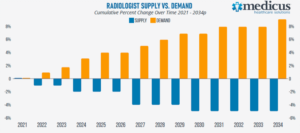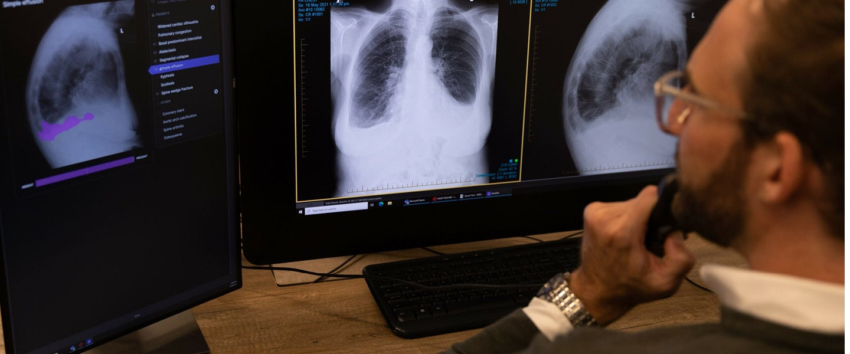The Gulf Cooperation Council (GCC) countries, renowned for their robust healthcare systems and investments in medical technology, are grappling with a critical shortage of radiologists at a time when Artificial Intelligence (AI) is transforming diagnostic practices.
As AI tools and algorithms increasingly assist with interpreting medical imaging, some fear that the shortage of human radiologists could significantly impact healthcare delivery in the region, which continues to expand and evolve with cutting-edge technologies.
Growing Demand for Radiologists
The GCC countries—namely Saudi Arabia, the United Arab Emirates, Qatar, Kuwait, Bahrain, and Oman—are facing an escalating demand for healthcare services due to their growing populations, increasing prevalence of chronic diseases, and booming medical tourism industry.
At the heart of this demand is the critical role played by radiologists in diagnosing conditions from cancer to fractures, to neurological disorders, all via imaging technologies like X-rays, CT scans, and MRIs.
However, with a limited workforce in the field, the region is confronted with a situation in which patient care could be delayed, affecting the timeliness of diagnosis and treatment. Recent studies have highlighted that radiologist shortages are being felt more acutely, with healthcare systems struggling to fill vacancies and meet growing patient demands for imaging services.
In April of this year, the frontrunner in tele radiology secured $860,000 in a pre-Series A funding round to accelerate its expansion in the Middle East and Africa. Following the acquisition of Arkan United, it is now entering Saudi Arabia, which boasts the largest healthcare industry in the region.
The Role of AI in Healthcare
In response to the shortage of human radiologists, the adoption of AI tools has soared within GCC healthcare systems. AI technologies are increasingly capable of reading and interpreting medical imaging with high accuracy, often rivalling the diagnostic abilities of human radiologists. AI’s potential to alleviate workload pressures and assist in routine tasks is seen as a promising solution to the current challenges.
AI-driven platforms, such as Deep Learning algorithms, are helping identify anomalies, such as tumors or fractures, with remarkable precision. With machine learning applications becoming more sophisticated, AI tools continue to evolve, promising greater efficiency, quicker turnaround times, and improved accuracy. The ability of AI to work around the clock without experiencing fatigue also plays a vital role in responding to the radiologist shortage.
However, while AI is transforming medical imaging, it also presents a unique challenge: balancing human expertise and machine automation. Experts caution that AI should complement, not replace, human radiologists. It is still essential to have medical professionals overseeing diagnoses to ensure comprehensive care and to manage more complex cases, where AI might not always capture every nuance that an experienced radiologist might identify.
Bridging the Gap: Investments in AI and Training
With AI’s integration growing steadily, GCC countries are making considerable investments in training healthcare professionals. The goal is to ensure that radiologists are equipped to work alongside AI systems effectively. Upskilling the existing workforce and attracting young talent to the field of radiology are seen as critical measures in addressing the shortage.
Additionally, healthcare providers in the GCC region are focusing on improving educational curricula to prepare future radiologists for the increasing role of AI in their work. Many medical universities now offer specialized courses in radiology and AI to create a workforce capable of navigating the future of diagnostic medicine. These initiatives aim to build a bridge between cutting-edge technology and human expertise, ensuring that radiologists are ready to collaborate with AI, rather than compete with it.

Radiation Protection
The growing awareness among professionals working with radiation about the risks associated with radiological exposure has driven the implementation of rigorous safety protocols. Since 1994, numerous regional initiatives and conferences focused on protection against ionizing radiation have been held. A notable recent effort took place in July 2005 at Rafic Hariri University Hospital, in collaboration with the Lebanese Atomic Energy Center and the International Atomic Energy Agency (IAEA), an agency of the United Nations (UN). These events have played a significant role in emphasizing safety measures and the importance of radiation protection in the region.
The Future of Radiology
The Arab region, rich in natural resources and human talent, has faced numerous challenges due to historical conflicts and sanctions that have impeded its development, including in the field of radiology. Despite these difficulties, the region continues to show significant promise for progress, especially in healthcare. The future of radiology lies in strengthening inter-Arab collaboration, enhancing medical training, and overcoming the barriers that have historically hindered the advancement of radiology services. Collaborative efforts among countries in the region could pave the way for improvements in the delivery of diagnostic services, contributing to healthier populations and a more robust healthcare infrastructure.
Recommendations
To improve the capabilities and accessibility of interventional radiology in the region, the Saudi Interventional Radiology Society offers several recommendations:
- Encourage Healthcare Centers: Healthcare centers that meet the required criteria should pursue accreditation for interventional radiology fellowships, ensuring high-quality training.
- Expand Training Positions: Accredited training centers should increase the number of available positions for interventional radiology training without compromising quality.
- Raise Awareness Among Students: Medical students and radiology residents should be made more aware of interventional radiology as a viable career path to bolster trainee recruitment.
- Support External Funding: Funding opportunities should be facilitated to support interventional radiology residency and fellowship programs, allowing broader participation.
- Direct Recruitment of Interventional Radiologists: It is crucial to address the shortage by recruiting full-time interventional radiologists, particularly in regions where services are limited.
- Primary Setting Coverage: Encourage practicing interventional radiologists to work in primary settings in compliance with national regulations.
Conclusion
While technological advancements, particularly in AI, continue to enhance the GCC region’s healthcare system, the shortage of radiologists remains a pressing concern. AI technologies hold great potential for supplementing human radiologists, but they cannot replace the human touch essential for thorough patient care. In the future, collaboration between radiologists and AI has the potential to bridge the workforce gap, opening up new frontiers in diagnostic healthcare across the region. However, addressing the current workforce shortage through targeted training, education, and recruitment efforts will remain crucial for ensuring sustainable healthcare improvement.
Sources
